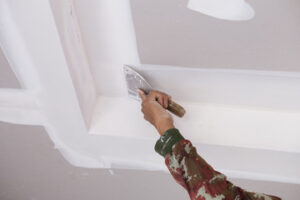Drywall Repair Las Vegas requires knowledge and skill, but many homeowners are able to do it themselves. The cost of a do-it-yourself drywall project depends on the size and type of damage.
The easiest and least expensive way to patch minor dents, nail and screw holes, and cracks are to fill them with lightweight spackle. Then sand them to level them with the rest of the wall.
Drywall cracks are usually minor issues that can be repaired easily, but they can also be a sign of larger problems that should be addressed as soon as possible. They can be caused by a variety of factors, including settling in new homes, water damage from leaks, and foundation problems that cause the drywall to deflect.
While a lot of homeowners fix these cracks, the result is typically unsightly and not always permanent. The most important thing is to keep these cracks at bay by regularly inspecting the underlying foundation for signs of problems and taking care of them as soon as they appear.
Homeowners can fix drywall cracks using various methods, depending on the size and severity of the crack. If the crack is small, a simple putty or spackle application can work effectively.
For cracks that are deeper or wider, a drywall patch can be applied to fill in the hole and restore a smooth surface. These patches are often available at home improvement centers or online.
Another option for repairing cracks is to apply a new layer of drywall compound over the old one. This will provide a reinforced, thicker surface to prevent the crack from reappearing in the future.
If a new coat of drywall compound is not enough to fix the problem, re-tape the crack instead. This will give the extra drywall strength and will allow the wall to withstand slight temperature fluctuations and normal expansions and contractions without showing the crack again.
Re-taping is not as easy to do as filling a crack with drywall mud, but it’s much more effective in the long run. A homeowner can re-tape the crack with some paper tape, but it’s best to use thicker, stronger drywall joint tape that can stand up to expansion and contraction.
Re-taping is especially crucial when the crack is on a seam where two pieces of drywall meet. These joints are much weaker than the center of a wall, so they’re more susceptible to cracking.
Drywall holes are unsightly, but they can also be a safety hazard. They can be caused by moving furniture, dings, or dents from kids or pets playing indoors and can be an entry point for pests like rodents.
There are a number of ways to fix drywall holes, ranging from simple sanding and touch-up paint to replacing the entire section of drywall. The repair process will depend on the size of the hole.
Minor holes are quick and easy to repair with a putty knife and joint compound. Larger holes are more extensive and require a piece of drywall to use as a patch.
To repair a small hole, cut a piece of drywall about 2 inches larger than the diameter of the hole in width and height. Tape the edges with mesh tape, which will prevent shifting and help the patch stick to the wall.
Apply a thin layer of joint compound over the entire patch, including the tape. Let it dry completely per the manufacturer’s instructions. Once the joint compound is fully dry, sand the patch so that it is smooth and flush with the wall.
Once the repair is smooth, you can paint it as needed to match the rest of the wall. Be sure to pay attention to the edges of the repair so they don’t stand out when you’re painting.
Using a drywall patch kit is a quick and easy way to repair holes that are around the size of a doorknob. These kits come with self-adhering mesh patches that stick to the drywall and cover the hole.